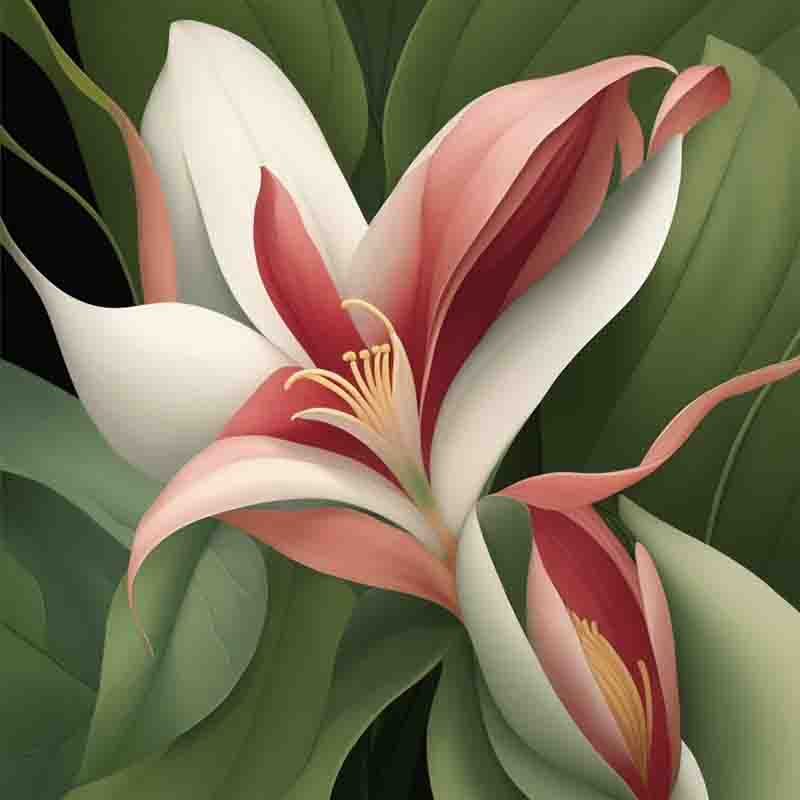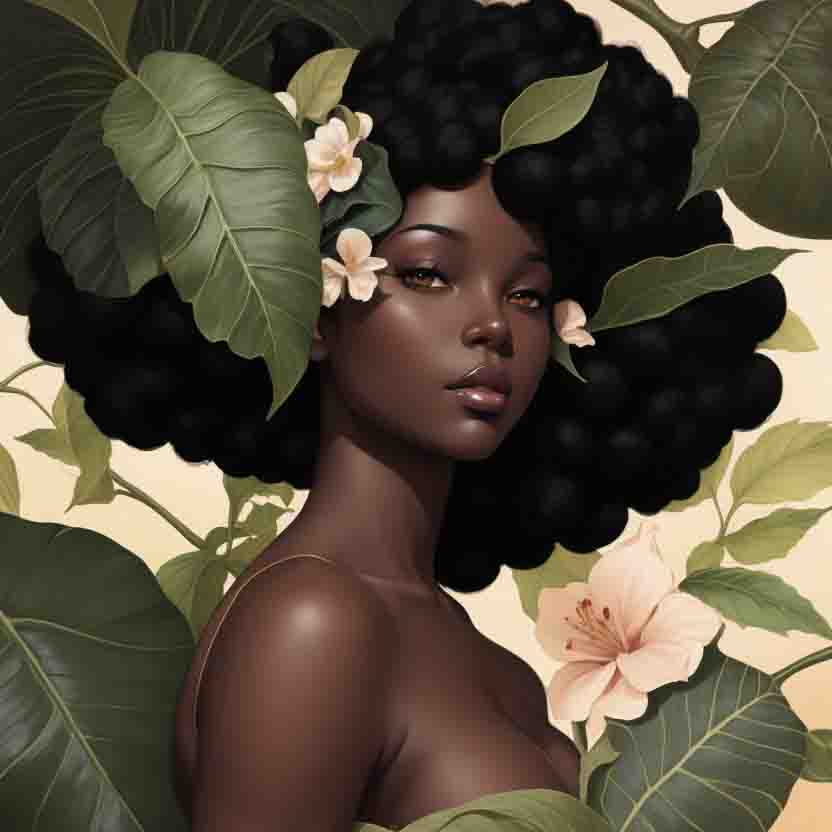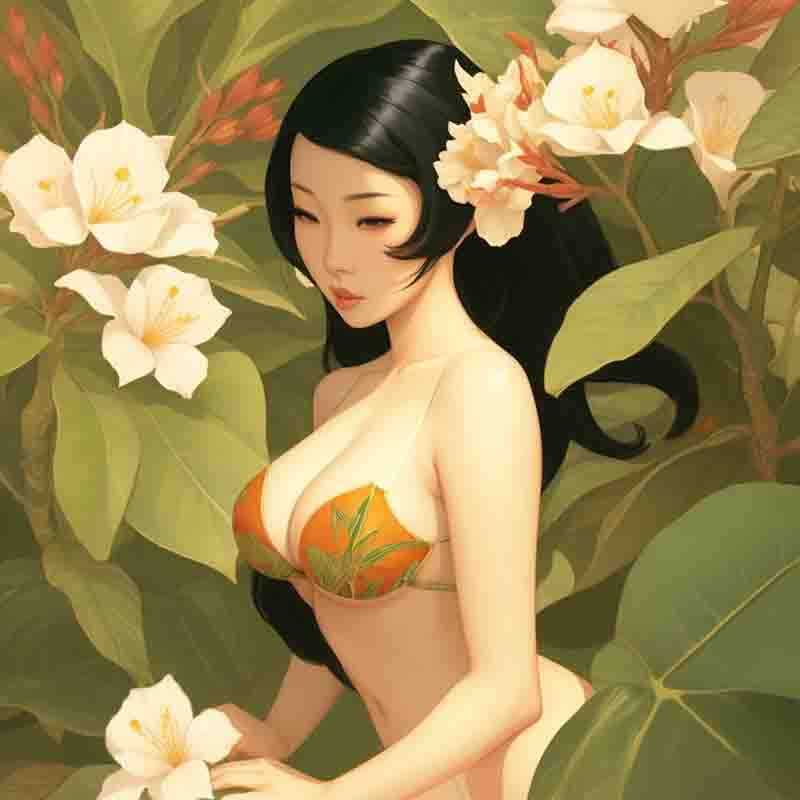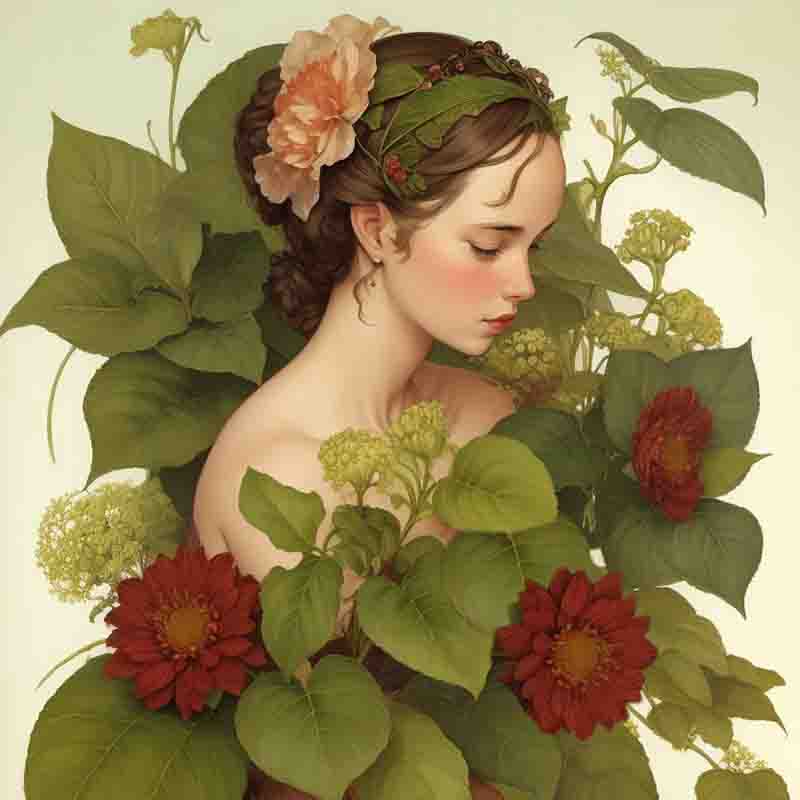Exploring the World of Botanical Art
Botanical art is a captivating intersection of science and art, where the intricate beauty of plant life is meticulously portrayed with a harmonious blend of precision and creativity.

Historically, botanical art has roots in scientific illustration, where artists worked closely with botanists to document plant species for research and classification purposes. Over time, the discipline has evolved, with contemporary botanical artists exploring a broader range of styles and interpretations.
At its core, botanical art seeks to capture the essence of plants through a lens that is both scientifically accurate and aesthetically appealing.
Artists in this genre meticulously observe and study plant specimens, honing their skills to convey the nuanced details of botanical subjects.
Botanical art employ various techniques, such as watercolor, graphite, colored pencils, and digital art mediums, to recreate the delicate features of flowers, leaves, stems, and other botanical elements.
The emphasis lies not only on achieving visual accuracy but also on infusing the artwork with a sense of life and vitality.
This dual purpose makes botanical art a unique form of representation, as it serves both artistic and scientific objectives.
Botanical art is one of the most popular concepts in the history of photography and has also found its position in modern contemporary art.
Utilizing a combination of precise observation, technical skill, and creative interpretation, botanical artists aim to capture the intricate details of plants, including their anatomy, color, and overall beauty.
Botanical Art Timeline
Botanical art contributes significantly to our understanding of plant diversity and ecology.
Through detailed depictions, it aids in plant identification and documentation, playing a crucial role in botanical research and conservation efforts.
Beyond its scientific utility, botanical art has a timeless allure, appealing to those who find inspiration in the delicate intricacies of the natural world.
| Time Period | Key Events |
|---|---|
| Ancient Times | Early botanical drawings in ancient civilizations for medicinal purposes. |
| 15th century BC | The earliest known examples of botanical art are found in Egypt. |
| 1526 | The Renaissance saw a renewed interest in botanical art, as artists began to use more naturalism and realism in their depictions of plants. Albrecht Dürer's "Tuft of Cowslips" (1526) is a famous example of this period. |
| 1530 | Leonhart Fuchs publishes "De historia stirpium," a landmark book of botanical illustrations that sets new standards for accuracy and detail. |
| 1700-1850 | This period is known as the Golden Age of Botanical Art. Artists such as Pierre-Joseph Redouté, Franz Bauer, and Margaret Meen produced stunningly detailed illustrations of plants. |
| 1688 | Maria Sibylla Merian publishes "Erxleben's Raupenbuch," a groundbreaking book of botanical illustrations that shows insects in their natural habitat. |
| 1703 | Carl Linnaeus publishes "Species Plantarum," the first comprehensive taxonomy of plants, which includes many of the illustrations that were created by Redouté, Bauer, and Meen. |
| 1750s | The Swedish botanist Carl Linnaeus develops the binomial nomenclature system for naming plants and animals, which is still in use today. |
| 1826 | The invention of photography in the middle of the 19th century boosted the appreciation of botanical art. |
| 20th Century | The 20th century marked a transformative period for botanical art, as it evolved from a purely scientific endeavor to a more artistic and expressive medium. |
| 21st century | The 21st century has witnessed a remarkable renaissance of botanical art, with artists from around the globe embracing a resurgence of interest in this captivating art form. |
This table provides a summarized timeline of key milestones in the history of botanical art, highlighting significant developments and shifts in artistic approaches across different periods.
Elevate Nature to Canvas

While botanical art retains its scientific relevance, it has also become a celebrated form of fine art, attracting enthusiasts who appreciate the fusion of precision and creative expression.
The Aesthetic Essence of Botanical Art
At the heart of botanical art lies an intricate dance between artistic expression and the inherent beauty of the plant kingdom.
The genre demands detailed observation, compelling artists to delve into the nuances of each leaf, petal, and stem.
This dedication to meticulous observation allows for the celebration of vibrant colors and diverse textures found in the natural world.
Botanical art becomes a visual symphony where the harmony of colors and textures intertwines to create captivating compositions.
Beyond mere aesthetics, botanical art often carries profound symbolism, with certain plants holding cultural significance.
Artists infuse meaning into their works, elevating botanical art to a realm where each illustration tells a story beyond the visual splendor, connecting viewers to the deeper essence of nature.
Techniques and Mediums in Botanical Art

From historical manuscripts to contemporary digital installations, botanical art continues to captivate audiences with its timeless beauty and contribution to our understanding of the natural world.
The execution of botanical art involves a palette of techniques and mediums that artists deftly wield to bring plants to life on canvas or paper.
Watercolor emerges as a favored medium, with its transparent and luminous qualities allowing artists to capture the delicacy and vibrancy of botanical subjects.
This technique demands precision, as each brushstroke plays a role in conveying the intricate details of the plants.
Pen and ink, another prominent medium in botanical art, offers artists the ability to create intricate line work and detailed illustrations.
This technique, characterized by its precision, is particularly adept at capturing the fine details of botanical specimens.
In the contemporary era, technology has opened new avenues for botanical artists, with digital tools providing innovative ways to create intricate and realistic illustrations.
The intersection of traditional techniques and digital advancements showcases the adaptability of botanical art in the ever-evolving landscape of artistic expression.
The Intersection of Science and Art
Botanical art's unique position at the intersection of science and art is evident in the collaborative efforts between artists and botanists.
The partnership between these two disciplines goes beyond mere aesthetics, contributing to scientific documentation and discovery.
Botanical artists often collaborate with botanists to create detailed illustrations that aid in plant identification and classification.
The emphasis on scientific accuracy becomes a hallmark of botanical art, where artists act as meticulous documentarians of the plant kingdom.
This intersection enhances the educational value of botanical art, making it a valuable tool in the realms of botany and environmental science.
The detailed depictions serve not only artistic purposes but also become vital resources for scientific study and research.
Botanical Art in Contemporary Culture

Botanical art explores an array of themes, from detailed plant portraiture to broader depictions of entire ecosystems.
As we traverse the annals of contemporary art, botanical art maintains its relevance and captivation.
Notable artists in the modern era contribute significantly to the genre, infusing it with new perspectives and styles.
Their works showcase a seamless integration of traditional techniques with innovative approaches, keeping botanical art dynamic and engaging.
The contemporary art scene witnesses a resurgence of interest in botanical art, with exhibitions and galleries featuring these works gaining popularity.
The enduring appeal of botanical subjects transcends time, creating a bridge between the classical and the modern, making botanical art a timeless expression that continues to thrive in contemporary culture.
The Therapeutic Benefits of Botanical Art
Beyond its aesthetic appeal, botanical art unfolds as a therapeutic practice, both for creators and appreciators.
The process of creating botanical art cultivates a meditative state, rooted in mindful observation and deliberate execution.
Artists find solace in the deliberate pace, redirecting their minds from the chaos of daily life to the tranquility of the present moment.
This mindful creation extends to the appreciation of botanical art, where viewers engage in a form of visual meditation.
The detailed compositions invite contemplation, fostering a sense of calmness and providing a respite from the demands of the outside world.
Botanical art, whether created or appreciated, becomes a therapeutic sanctuary, offering a space for introspection, relaxation, and a profound connection to the soothing beauty of the natural world.
Using Botanical Art in Interior Design

Botanical wall art has become a popular choice for interior décor, bringing the calming influence of nature into homes and workspaces.
The aesthetic allure and calming qualities of botanical art find a natural home within the realm of interior design.
The celebration of nature's beauty becomes a transformative element in indoor spaces, infusing them with a sense of tranquility and sophistication.
Botanical art serves as more than mere decoration; it becomes a curated expression of the homeowner's connection to the natural world.
In living spaces, large botanical prints or curated collections on feature walls create focal points that anchor the ambiance.
The integration of botanical art into bedrooms fosters serene retreats, while kitchens and dining areas benefit from the vibrant and culinary-themed illustrations.
Beyond walls, customization options like murals and botanical textiles offer personalized design choices, allowing individuals to immerse themselves in the therapeutic ambiance of botanical art within their living spaces.
Plant Portraiture and Flora Depiction
From historical manuscripts to contemporary digital installations, this genre continues to captivate audiences with its timeless beauty and contribution to our understanding of the natural world.
Botanical art serves as a powerful tool for art, education, and conservation.
-
Botanical Illustration: Botanical illustration is a captivating art form that intricately captures the beauty of plant life with both scientific accuracy and artistic finesse. The process of botanical illustration involves keen observation, detailed study, and a deep appreciation for plant anatomy.
-
Plant Portraiture: Plant portraiture is an intimate exploration of individual plants, aiming to capture their unique essence and beauty. The goal is to create visual portraits that not only showcase the botanical features but also evoke a sense of connection and appreciation for the individuality of each plant.
-
Scientific Accuracy: Scientific accuracy is the hallmark of botanical art, distinguishing it from traditional art forms by its commitment to portraying plant life with precision and authenticity. The pursuit of scientific accuracy begins with the careful selection of plant specimens.
-
Flora Depiction: Flora depiction in botanical art involves the visual representation of plant life, showcasing the diversity and beauty of the botanical world. This direct connection with the natural world informs the artistic process, enabling artists to create authentic and evocative representations of plant life.
-
Precision in Art: Precision in art is a fundamental aspect of botanical illustration and botanical art in general. The challenge lies in striking a balance between accurate representation and artistic interpretation.
-
Plant Anatomy: Plant anatomy is a crucial aspect of botanical art, emphasizing the detailed study and accurate representation of the internal and external structures of plants. From the venation patterns on leaves to the arrangement of floral parts, plant anatomy serves as a foundational element in creating accurate and informative botanical artworks.
-
Naturalistic Representation: Naturalistic representation in botanical art involves the portrayal of plants in a manner that closely mimics their appearance in their natural habitat. This holistic approach not only enhances the visual appeal of the artwork but also provides viewers with a broader understanding of the interconnectedness of plant life within its natural setting.
-
Botanical Diversity: Botanical diversity is a central theme in botanical art, showcasing the vast array of plant species found across the globe. Botanical diversity is a source of inspiration for artists, prompting them to experiment with different styles and techniques to capture the essence of each plant.
-
Aesthetic Interpretation: Aesthetic interpretation in botanical art involves infusing the representation of plants with a sense of artistic flair and creativity. This storytelling aspect transforms botanical art into a form of visual poetry, where each artwork tells a unique story about the plants it portrays.
-
Watercolor Techniques: Watercolor techniques play a significant role in botanical art, offering artists a versatile and expressive medium to bring their botanical subjects to life. Through the skillful application of watercolor, botanical artists bring a sense of life and movement to their creations, inviting viewers to immerse themselves in the vibrant world of plants.
-
Graphite Rendering: Graphite rendering is a technique in botanical art that involves the use of graphite pencils to create detailed and precise illustrations. The controlled application of graphite allows for meticulous detailing, making it a preferred medium for artists aiming to represent plants with scientific accuracy.
-
Colored Pencil Art: Colored pencil art in botanical illustration is a vibrant and expressive medium that allows artists to infuse their creations with a spectrum of colors. Attention to texture adds a tactile quality to the artwork, inviting viewers to visually explore the intricacies of plant anatomy.
-
Digital Botanical Art: Digital botanical art represents a contemporary evolution in the field, leveraging digital tools and technologies to create intricate and visually stunning illustrations. The versatility of digital tools enables artists to produce vibrant and lifelike representations of plants, enhancing the visual impact of their artworks.
-
Scientific Documentation: Scientific documentation is a fundamental aspect of botanical art, especially in botanical illustration. The detailed depictions aid in plant identification, allowing scientists to classify and understand the characteristics of different species.
-
Plant Classification: Plant classification is a key focus in botanical art, particularly in botanical illustration. The precision and accuracy in these illustrations are paramount to their scientific value. These resources play a vital role in advancing botanical knowledge and education.
-
Ecology Representation: Ecology representation in botanical art involves the portrayal of plants within their natural ecosystems, showcasing the intricate relationships between flora and their environments. Botanical artists contribute to a broader understanding of ecosystems and their ecological dynamics.
-
Fine Art Integration: Fine art integration in botanical illustration involves merging traditional artistic elements with botanical accuracy. The goal is to create artworks that are not only scientifically informative but also visually captivating.
-
Botanical Research: Botanical research is a collaborative effort between scientists and botanical artists to explore, document, and understand the plant kingdom. Beyond individual species, botanical research may involve the depiction of plant communities and ecosystems.
-
Conservation Contribution: Conservation contribution in botanical art involves using artistic creations to raise awareness about endangered plant species and advocate for the preservation of biodiversity.
-
Nature-Inspired Creativity: Nature-inspired creativity in botanical art involves using the diverse forms, colors, and patterns found in the plant kingdom as a wellspring of inspiration for artistic expression. Botanical artists draw on the inherent beauty of plants to fuel their creativity, creating artworks that reflect not only scientific accuracy but also the awe and wonder inspired by the natural world.
The hallmark of botanical art is precision. Artists meticulously observe and study plant anatomy, from the delicate veins on a leaf to the intricate structure of a flower. Scientific tools such as magnifying glasses and microscopes further enhance the level of detail, ensuring that each artwork is a testament to the intricacies of nature.
The Enduring Allure of Botanical Art
The therapeutic benefits, both in the process of creation and the act of appreciation, underscore its profound impact on the human experience.
Botanical art, a captivating fusion of art and science, traces its roots through the annals of art history, emerging as a visual language that communicates the intricate beauty of plant life.
Defined by its meticulous depictions of flora, botanical art transcends mere aesthetic appreciation, offering a profound exploration of nature's wonders.
Originating from ancient civilizations, it has evolved over the centuries, reflecting changing styles, techniques, and purposes.
Botanical art, with its timeless appeal, invites us to explore, appreciate and find comfort in the delicate flowers that capture the essence of life.
Botanical Art: FAQ
Are you curious about music, art, technology, fashion, lifestyle, and beer?
If so, then you need to subscribe to the free Likewolf newsletter.
100% privacy. When you sign up, we'll keep you posted.
Spaces into Havens
The Power of Wall Art
